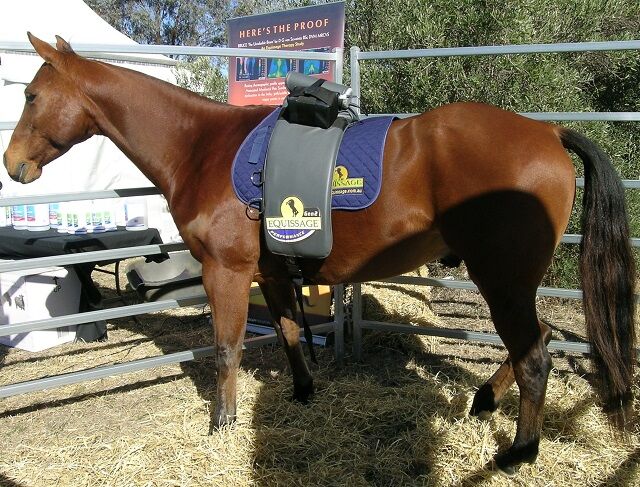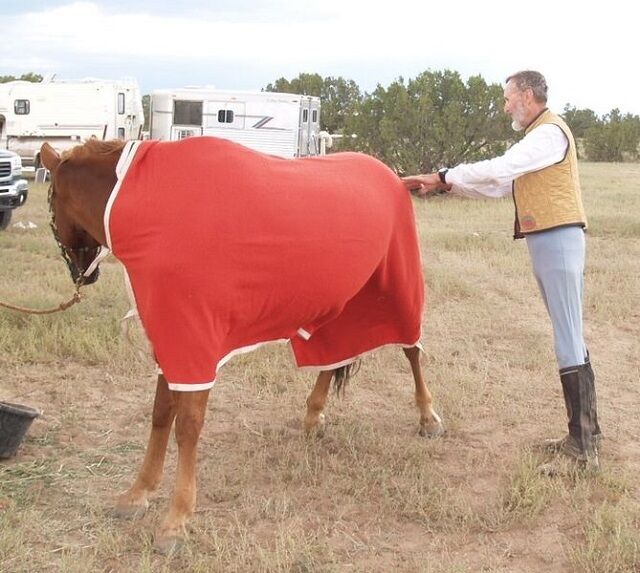
Image credit: Cgoodwin, CC BY-SA 3.0, via Wikimedia Commons
The Fascinating World of Equine Massage Therapy
Equine massage therapy is a holistic horse treatment that is becoming increasingly popular in the equestrian world. Therapists use a combination of their bodies and tools to work horses’ soft tissue. Primarily, this process is designed to increase blood flow, loosen stiff parts of the musculoskeletal system, and reduce stress.
This post will explore equine massage therapy’s history, benefits, and varying techniques.
A Brief History of Equine Massage Therapy
People have performed human-to-human massages for thousands of years. The treatment was so popular that in AD 581, the Chinese Office of Imperial Physicians constructed a department of massage therapy. However, the documented horse massage industry didn’t arrive until the 20th century.

Image credit: Una Smith, CC BY-SA 3.0, via Wikipedia
The first known professional horse masseur was Jack Meagher, a former American military medic turned athlete physical therapist. His massages gained a reputation for effectively working sore and tense soft tissue. In 1970, Jack’s friend asked him to treat an old quarter horse that was struggling to move. Jack gave the horse a massage and claimed that it looked as energetic as a colt. This experience showed the therapist how his skills could benefit the equine world.
In 1976, Jack worked with the U.S. equestrian team competing in the Montreal Olympics. His involvement with the team set a new standard of quality for horse treatment at the professional level.
Today, equestrian facilities reflect equine massage therapy’s evolution. Serious horse enthusiasts maintain access to vibrating platforms, hyperbaric oxygen chambers, and cold saltwater spas. Modern therapists incorporate these tools with massage, partially to improve the treatment’s effectiveness.
The Benefits of Equine Massage Therapy
Modern research has determined that equine massage therapy offers multiple benefits.
-
Improved circulation: Massages increase blood flow by boosting arterial pressure and muscle temperature. Consistent circulation performs the critical task of bringing oxygen and nutrients to an area and removing waste. So, injury recovery speeds rise once blood flow improves. -
Reduced pain reception: Researchers have concluded that massages reduce pain reception in horses. Observers noted this effect for seven days, with the final day showing notable pain reduction. -
Decreased physiological stress: Early studies indicate that massages relax recipients through a combination of improved blood flow, hormonal stimulation, and heart rate alleviation. -
Increased range of motion: Experts suggest that massages diminish tension caused by binding joints for protection. Following the removal of this binding, kneading the bound area will cause surrounding muscles to relax. So, horses can move with greater flexibility.
Myofascial Release
Myofascial release uses consistent pressure to change fascial substances from a gel state to a more liquid state. Practitioners describe this effect as thixotropy. Therapists often maintain myofascial pressure until they feel a release, which may indicate a fascial consistency change or relaxation from a stress point.
A study of 31 patients undergoing myofascial release revealed notable reported boosts in pain reduction and mobility. Additionally, researchers found that the treatment improved diastolic blood pressure and heart rate flexibility following high-intensity exercises. Because of these benefits, owners often employ myofascial release during an injury or exercise recovery period.
Swedish Massage
Swedish massage is a flexible method that incorporates different techniques targeted at achieving unique goals. Therapists may use these methods individually, but they are typically applied in sequence.
-
Tapotement: Tapotement is a rhythmic tapping designed to stimulate the nervous system and release the back’s lymphatic buildup. So, many owners use it as an introductory massage before proceeding to smoother rubbing. -
Petrissage: Petrissage is the application of deep pressure to muscles. This technique is most effective at loosening tissue. Therapists who need to work out knots may employ petrissage. -
Effleurage: Effleurage is a gentle sliding of the therapist’s hand along a body area. On an animal the size of a horse, this technique primarily serves a calming purpose. Owners may end heavier massage bouts with effleurage to communicate a relaxing close to the session.
Shiatsu
Shiatsu is a Japanese-originating massage designed to improve the recipient’s whole body. It focuses on manipulating energy pathways that exist within all living beings. Depending on how these pathways align, the recipient can receive a diverse range of benefits.
While its medical effects are less well documented than its competitors, Shiatsu has a dedicated practitioner base. Because of its holistic nature, these users tend to apply the massage liberally. So, owners may employ Shiatsu for pressure release, relaxation, and general improvements in their horses’ well-being.
Trigger Point Therapy
Trigger point therapy is a technique that targets stress points to release tension. Practitioners will focus firm pressure on spots that show signs of limited mobility. Modern ultrasounds and imaging can assist in finding stress points by revealing soft tissue layouts. Trigger point therapy is especially popular as a tool to eliminate localized deep-seated tension.
Craniosacral Therapy
Craniosacral therapy centers a light touch around the spinal region. The technique’s goal is to manage the flow of spinal fluid in a manner that improves the overall mental and physical health of the recipient. Like Shiatsu, craniosacral therapy is a holistic method, so its users apply it for a broad range of purposes.
Conclusion
Horse owners who wish to capitalize on equine massage’s benefits may be overwhelmed by their options. In such cases, Equine Massage: A Practical Guide by Jean-Pierre Hourdebaigt may offer a solution. The book gives crucial details regarding horse anatomy, massage techniques, and routine health maintenance. Order the guide now to start delivering equine massage therapy with the right strokes.
Key Takeaways
- Innovative tools and techniques are rapidly transforming equine massage into medical science.
- Modern research supports equine massage’s health-boosting effectiveness.
- Myofascial release and trigger point therapy relax deep-seated stress points.
- Swedish massage offers several unique techniques that can be used individually or sequentially.
- Shiatsu and craniosacral therapy are holistic massages that aim to improve overall well-being.


